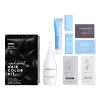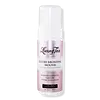What's inside
What's inside
 Key Ingredients
Key Ingredients

 Benefits
Benefits

 Concerns
Concerns

 Ingredients Side-by-side
Ingredients Side-by-side

Water
Skin ConditioningCetyl Alcohol
EmollientPropylene Glycol
HumectantEthanolamine
BufferingCetearyl Alcohol
EmollientCeteareth-25
CleansingToluene-2,5-Diamine Sulfate
Cocamide Mea
EmulsifyingCocamidopropyl Betaine
CleansingCeteth-2
EmulsifyingPolyquaternium-6
Argania Spinosa Kernel Oil
EmollientHydrolyzed Keratin
HumectantPanax Ginseng Root Extract
EmollientDimethicone
EmollientAscorbic Acid
AntioxidantDisodium EDTA
Sodium Sulfite
PreservativeSodium Hydrosulfite
Silica
AbrasiveXanthan Gum
EmulsifyingButylene Glycol
Humectant2-Amino-4-Hydroxyethylaminoanisole Sulfate
2-Methylresorcinol
M-Aminophenol
2-Amino-3-Hydroxypyridine
2,4-Diaminophenoxyethanol Hcl
Hydrogen Peroxide
AntimicrobialSodium Laureth Sulfate
CleansingOxyquinoline Sulfate
AntimicrobialPentasodium Pentetate
Phosphoric Acid
BufferingTetrasodium EDTA
Etidronic Acid
Isopropyl Alcohol
SolventGlycerin
HumectantPolysorbate 20
EmulsifyingSodium Cocoyl Glutamate
CleansingSodium Lauroyl Glutamate
Disodium Cocoyl Glutamate
CleansingTetrasodium Glutamate Diacetate
Ethylhexylglycerin
Skin ConditioningPhenoxyethanol
PreservativeParfum
MaskingParaffinum Liquidum
EmollientPvp
Emulsion StabilisingPEG-40 Hydrogenated Castor Oil
EmulsifyingStearic Acid
CleansingAcrylates/C10-30 Alkyl Acrylate Crosspolymer
Emulsion StabilisingGlyceryl Stearate
EmollientPEG-100 Stearate
Sodium Hydroxide
BufferingSodium Lauroyl Methyl Isethionate
CleansingSodium Cocoyl Isethionate
CleansingDisodium Cocoamphodiacetate
CleansingAloe Barbadensis Leaf Juice
Skin ConditioningGlycol Distearate
EmollientPEG-120 Methyl Glucose Dioleate
EmulsifyingKeratin
Skin ConditioningHydrolyzed Lupine Seed Extract
Skin ConditioningHydrolyzed Rice Protein
Skin ConditioningHydrolyzed Quinoa
Skin ConditioningPanthenol
Skin ConditioningCocamidopropyl Hydroxysultaine
CleansingGuar Hydroxypropyltrimonium Chloride
Skin ConditioningTrideceth-12
EmulsifyingPolyquaternium-10
Trimethylsiloxyamodimethicone
C11-15 Pareth-7
EmulsifyingCocamidopropyl Dimethylamine
EmulsifyingBenzyl Alcohol
PerfumingCaprylhydroxamic Acid
Sodium Chloride
MaskingStearyl Alcohol
EmollientPolyquaternium-7
Behentrimonium Chloride
PreservativeStearalkonium Chloride
PreservativeJojoba Esters
EmollientBeta-Glucan
Skin ConditioningGlycolic Acid
BufferingHydrolyzed Vegetable Protein Pg-Propyl Silanetriol
Skin ConditioningAmodimethicone
Cetrimonium Chloride
AntimicrobialHydroxyethylcellulose
Emulsion StabilisingCetrimonium Bromide
AntimicrobialWater, Cetyl Alcohol, Propylene Glycol, Ethanolamine, Cetearyl Alcohol, Ceteareth-25, Toluene-2,5-Diamine Sulfate, Cocamide Mea, Cocamidopropyl Betaine, Ceteth-2, Polyquaternium-6, Argania Spinosa Kernel Oil, Hydrolyzed Keratin, Panax Ginseng Root Extract, Dimethicone, Ascorbic Acid, Disodium EDTA, Sodium Sulfite, Sodium Hydrosulfite, Silica, Xanthan Gum, Butylene Glycol, 2-Amino-4-Hydroxyethylaminoanisole Sulfate, 2-Methylresorcinol, M-Aminophenol, 2-Amino-3-Hydroxypyridine, 2,4-Diaminophenoxyethanol Hcl, Hydrogen Peroxide, Sodium Laureth Sulfate, Oxyquinoline Sulfate, Pentasodium Pentetate, Phosphoric Acid, Tetrasodium EDTA, Etidronic Acid, Isopropyl Alcohol, Glycerin, Polysorbate 20, Sodium Cocoyl Glutamate, Sodium Lauroyl Glutamate, Disodium Cocoyl Glutamate, Tetrasodium Glutamate Diacetate, Ethylhexylglycerin, Phenoxyethanol, Parfum, Paraffinum Liquidum, Pvp, PEG-40 Hydrogenated Castor Oil, Stearic Acid, Acrylates/C10-30 Alkyl Acrylate Crosspolymer, Glyceryl Stearate, PEG-100 Stearate, Sodium Hydroxide, Sodium Lauroyl Methyl Isethionate, Sodium Cocoyl Isethionate, Disodium Cocoamphodiacetate, Aloe Barbadensis Leaf Juice, Glycol Distearate, PEG-120 Methyl Glucose Dioleate, Keratin, Hydrolyzed Lupine Seed Extract, Hydrolyzed Rice Protein, Hydrolyzed Quinoa, Panthenol, Cocamidopropyl Hydroxysultaine, Guar Hydroxypropyltrimonium Chloride, Trideceth-12, Polyquaternium-10, Trimethylsiloxyamodimethicone, C11-15 Pareth-7, Cocamidopropyl Dimethylamine, Benzyl Alcohol, Caprylhydroxamic Acid, Sodium Chloride, Stearyl Alcohol, Polyquaternium-7, Behentrimonium Chloride, Stearalkonium Chloride, Jojoba Esters, Beta-Glucan, Glycolic Acid, Hydrolyzed Vegetable Protein Pg-Propyl Silanetriol, Amodimethicone, Cetrimonium Chloride, Hydroxyethylcellulose, Cetrimonium Bromide
Water
Skin ConditioningDihydroxyacetone
Skin ConditioningPropylene Glycol
HumectantEthoxydiglycol
HumectantErythrulose
TanningPanthenol
Skin ConditioningDecyl Glucoside
CleansingDimethicone
EmollientPhenoxyethanol
PreservativeEthylhexylglycerin
Skin ConditioningJuglans Nigra Shell Extract
AstringentAloe Barbadensis Leaf Juice
Skin ConditioningParfum
MaskingHydroxypropyl Methylcellulose
Emulsion StabilisingSodium Bisulfite
AntioxidantCI 16035
Cosmetic ColorantCI 14700
Cosmetic ColorantCI 19140
Cosmetic ColorantCaramel
Cosmetic ColorantCI 42090
Cosmetic ColorantWater, Dihydroxyacetone, Propylene Glycol, Ethoxydiglycol, Erythrulose, Panthenol, Decyl Glucoside, Dimethicone, Phenoxyethanol, Ethylhexylglycerin, Juglans Nigra Shell Extract, Aloe Barbadensis Leaf Juice, Parfum, Hydroxypropyl Methylcellulose, Sodium Bisulfite, CI 16035, CI 14700, CI 19140, Caramel, CI 42090
Ingredients Explained
These ingredients are found in both products.
Ingredients higher up in an ingredient list are typically present in a larger amount.
Aloe Barbadensis Leaf Juice comes from leaves of the aloe plant. Aloe Barbadensis Leaf Juice is best known for helping to soothe sunburns. It is also anti-inflammatory, moisturizing, antiseptic, and can help heal wounds.
Aloe is packed with good stuff including Vitamins A, C, and E. These vitamins are antioxidants, which help fight free-radicals and the damage they may cause. Free-radicals are molecules that may damage your skin cells, such as pollution.
Aloe Barbadensis Leaf Juice also contains sugars. These sugars come in the form of monosaccharides and polysaccharides, folic acid, and choline. These sugars are able to help bind moisture to skin.
It also contains minerals such as calcium, 12 anthraquinones, fatty acids, amino acids, and Vitamin B12.
Learn more about Aloe Barbadensis Leaf JuiceDimethicone is a type of synthetic silicone created from natural materials such as quartz.
What it does:
Dimethicone comes in different viscosities:
Depending on the viscosity, dimethicone has different properties.
Ingredients lists don't always show which type is used, so we recommend reaching out to the brand if you have questions about the viscosity.
This ingredient is unlikely to cause irritation because it does not get absorbed into skin. However, people with silicone allergies should be careful about using this ingredient.
Note: Dimethicone may contribute to pilling. This is because it is not oil or water soluble, so pilling may occur when layered with products. When mixed with heavy oils in a formula, the outcome is also quite greasy.
Learn more about DimethiconeEthylhexylglycerin (we can't pronounce this either) is commonly used as a preservative and skin softener. It is derived from glyceryl.
You might see Ethylhexylglycerin often paired with other preservatives such as phenoxyethanol. Ethylhexylglycerin has been found to increase the effectiveness of these other preservatives.
Panthenol is a common ingredient that helps hydrate and soothe the skin. It is found naturally in our skin and hair.
There are two forms of panthenol: D and L.
D-panthenol is also known as dexpanthenol. Most cosmetics use dexpanthenol or a mixture of D and L-panthenol.
Panthenol is famous due to its ability to go deeper into the skin's layers. Using this ingredient has numerous pros (and no cons):
Like hyaluronic acid, panthenol is a humectant. Humectants are able to bind and hold large amounts of water to keep skin hydrated.
This ingredient works well for wound healing. It works by increasing tissue in the wound and helps close open wounds.
Once oxidized, panthenol converts to pantothenic acid. Panthothenic acid is found in all living cells.
This ingredient is also referred to as pro-vitamin B5.
Learn more about PanthenolParfum is a catch-all term for an ingredient or more that is used to give a scent to products.
Also called "fragrance", this ingredient can be a blend of hundreds of chemicals or plant oils. This means every product with "fragrance" or "parfum" in the ingredients list is a different mixture.
For instance, Habanolide is a proprietary trade name for a specific aroma chemical. When used as a fragrance ingredient in cosmetics, most aroma chemicals fall under the broad labeling category of “FRAGRANCE” or “PARFUM” according to EU and US regulations.
The term 'parfum' or 'fragrance' is not regulated in many countries. In many cases, it is up to the brand to define this term.
For instance, many brands choose to label themselves as "fragrance-free" because they are not using synthetic fragrances. However, their products may still contain ingredients such as essential oils that are considered a fragrance by INCI standards.
One example is Calendula flower extract. Calendula is an essential oil that still imparts a scent or 'fragrance'.
Depending on the blend, the ingredients in the mixture can cause allergies and sensitivities on the skin. Some ingredients that are known EU allergens include linalool and citronellol.
Parfum can also be used to mask or cover an unpleasant scent.
The bottom line is: not all fragrances/parfum/ingredients are created equally. If you are worried about fragrances, we recommend taking a closer look at an ingredient. And of course, we always recommend speaking with a professional.
Learn more about ParfumPhenoxyethanol is a preservative that has germicide, antimicrobial, and aromatic properties. Studies show that phenoxyethanol can prevent microbial growth. By itself, it has a scent that is similar to that of a rose.
It's often used in formulations along with Caprylyl Glycol to preserve the shelf life of products.
Propylene Glycol is an odorless, colorless liquid. As a humectant, it helps skin retain moisture. It also aids in delivering active ingredients.
Another role of this ingredient is preventing a product from melting or freezing. Propylene glycol also adds antimicrobrial properties to a product, elongating product lifespan.
This ingredient is considered an organic alcohol and commonly added into both cosmetics and foods.
Those with sensitive skin or conditions may develop a rash when using this ingredient.
Learn more about Propylene GlycolWater. It's the most common cosmetic ingredient of all. You'll usually see it at the top of ingredient lists, meaning that it makes up the largest part of the product.
So why is it so popular? Water most often acts as a solvent - this means that it helps dissolve other ingredients into the formulation.
You'll also recognize water as that liquid we all need to stay alive. If you see this, drink a glass of water. Stay hydrated!
Learn more about Water